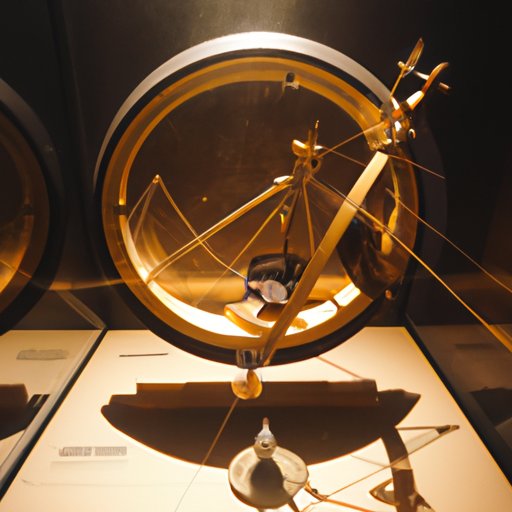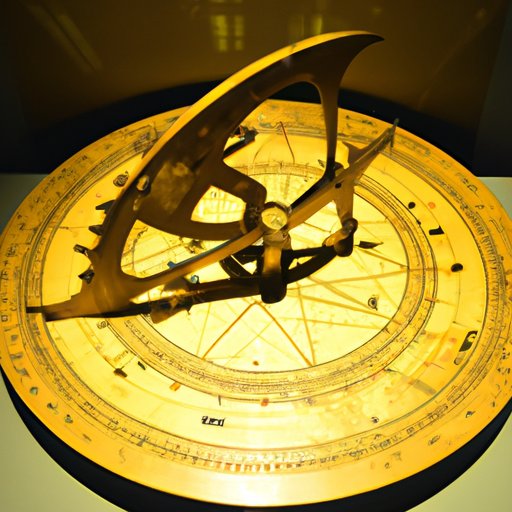Introduction
An astrolabe is an ancient astronomical instrument used for navigation, surveying, timekeeping, and astrology. The device was invented by ancient Greek astronomers in the 2nd century BC and has since been used by many cultures around the world. It is a highly versatile tool that can be used to measure angles, distances, and time. In this article, we will explore how an astrolabe works and examine its various applications and benefits.

Exploring the History and Design of the Astrolabe
The astrolabe was first developed by Hipparchus, a Greek astronomer and mathematician, during the 2nd century BC. He improved upon the earlier invention known as the dioptra, which had been used by other Greek mathematicians to measure the position of stars in the sky. The astrolabe quickly became a popular navigational tool and was widely used by sailors and travelers for centuries.
Modern astrolabes are typically made from brass or aluminum and consist of two main parts: the plate and the rete. The plate is a flat disk with a variety of scales, graduations, and markings used to measure angles and distances. The rete is a star-shaped frame that is mounted on top of the plate and contains pointers that indicate the positions of stars and constellations in the night sky.
Understanding the Functions and Mechanics of an Astrolabe
An astrolabe works by measuring the angle between two points in the sky. This is done by aligning the pointer on the rete with the desired point in the sky and then reading the angle off the plate. By doing this multiple times, it is possible to accurately calculate the position of any object in the sky. Additionally, astrolabes can be used to measure the time of day, the height of objects, and the distance between two points.
Astrolabes use a variety of different measurements, including degrees, minutes, and seconds. They also make use of trigonometric functions such as sine, cosine, and tangent. By combining these measurements and functions, astrolabes can accurately calculate the position of any object in the sky.
Analyzing How an Astrolabe Can Be Used
Astrolabes can be used for a variety of purposes, including navigation, surveying, astronomy, and astrology. They are commonly used by sailors and explorers to determine their location and direction at sea. They are also used by surveyors to measure distances and angles on land. Astrologers use astrolabes to calculate the positions of the planets and stars, while astronomers use them to observe and study celestial bodies.
Astrolabes are also useful for teaching students about basic geometry and trigonometry. By using an astrolabe, students can gain a better understanding of these mathematical concepts and learn how to apply them to real-world situations.
Examining Different Types of Astrolabes
There are a variety of different types of astrolabes available. Some are designed to be used for specific purposes, such as navigation or surveying, while others are more general-purpose instruments. The size and complexity of the astrolabe can vary significantly, depending on its intended use. For example, a large astrolabe may have more detailed scales and graduations than a smaller model.
Some astrolabes are designed to be used in different parts of the world. Different models may be calibrated for different latitudes and climates, allowing them to be used in different locations. Additionally, some astrolabes are designed to be used with electronic devices, such as computers or smartphones, to provide even greater accuracy and convenience.

Demonstrating How to Use an Astrolabe
Using an astrolabe is relatively simple, although it does take some practice to become proficient. First, the user must align the pointer on the rete with the desired point in the sky. Then, the user must read the angle off the plate and record it. The user can then repeat this process for multiple points in the sky to calculate the desired measurement.
For example, if the user wants to calculate the height of a building, they would first align the pointer on the rete with the top of the building. They would then read the angle off the plate and record it. Next, they would align the pointer with the bottom of the building and read the angle off the plate again. Finally, they would subtract the two angles to calculate the height of the building.

Describing the Benefits of Owning an Astrolabe
Owning an astrolabe can be beneficial in a variety of ways. In addition to its practical uses, the astrolabe has a rich cultural significance. For centuries, it has been used by sailors, explorers, and surveyors to navigate the seas and explore new lands. It is a symbol of adventure, discovery, and exploration, and owning one can be a source of pride and satisfaction.
Knowing how to use an astrolabe can also give you a greater appreciation for the science of astronomy and the beauty of the night sky. By understanding how an astrolabe works, you can gain a better understanding of the universe and appreciate the mysteries of the cosmos.
Conclusion
In this article, we explored how an astrolabe works and examined its various applications and benefits. We discussed the history and design of the astrolabe, as well as its functions and mechanics. We looked at the different types of astrolabes available and demonstrated how to use one. Finally, we discussed the practical and cultural benefits of owning an astrolabe. Knowing how to use an astrolabe can be a valuable skill, both practically and culturally.
(Note: Is this article not meeting your expectations? Do you have knowledge or insights to share? Unlock new opportunities and expand your reach by joining our authors team. Click Registration to join us and share your expertise with our readers.)
